Architectural Wonders Around Burj Khalifa
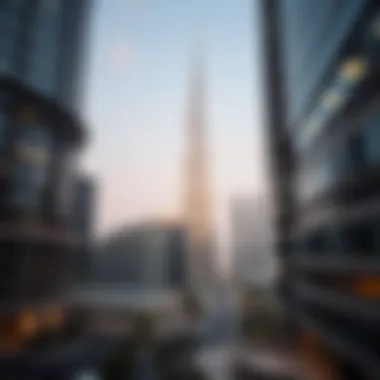
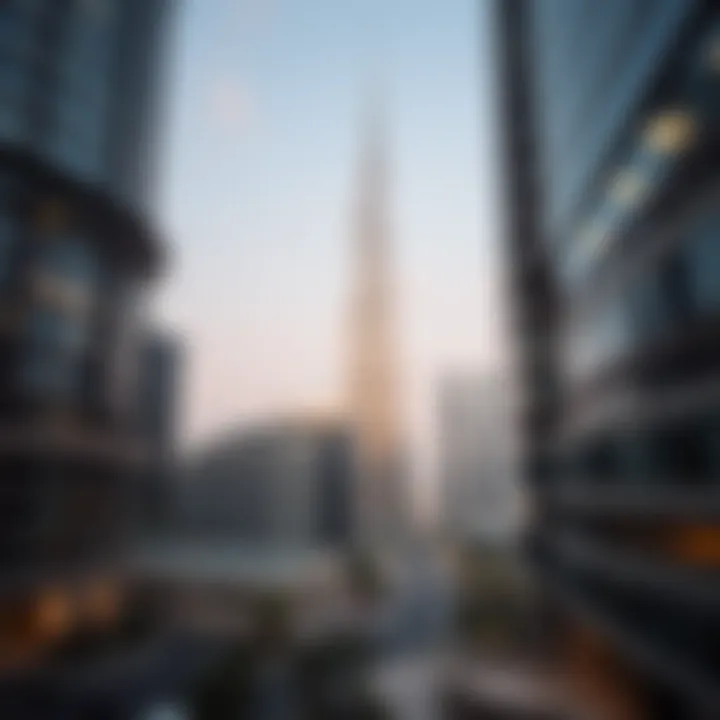
Intro
The Burj Khalifa, towering majestically over Dubai, is not alone in defining the skyline of this bustling metropolis. Surrounding this architectural marvel is a tapestry of structures, each contributing its own thread to the weave of the city's urban landscape. This article takes a closer look at these buildings, ranging from glitzy skyscrapers to spacious residential complexes. By understanding their architectural details, functionality, and how they interact with the market dynamics, potential investors and homebuyers can make informed choices in a property market that never sleeps.
Market Trends
Current Property Prices
Looking at the current property market around Burj Khalifa, prices can feel like an elevator ride straight to the top. The demand for both residential and commercial properties here remains strong, largely due to the area’s status as a global hub. Rental prices for apartments can fluctuate significantly; for instance, one-bedroom units can range from AED 80,000 to AED 150,000 annually, depending on the building's amenities and proximity to Burj Khalifa itself.
In the commercial sector, office spaces in towers like the Emirates Towers and the Dubai Mall area command premium prices. Lease rates can vary widely, with average rents around AED 1,800 to AED 3,000 per square meter. These numbers reflect not just the location but also the prestige and accessibility that these properties offer.
Future Market Predictions
As we peer into the crystal ball of Dubai’s real estate, growth seems to be on the horizon. Experts point to several critical indicators that suggest a steady uptick in property values over the next few years. With the ongoing developments in infrastructure, such as the expansion of the Metro and plans for new tourist attractions, the area surrounding Burj Khalifa is set to become even more enticing.
Analysts are predicting an annual property appreciation rate of 5% to 10%. This growth is particularly influenced by the increasing influx of expatriates and investors looking to be part of a cosmopolitan lifestyle. Additionally, the proliferation of luxury amenities and lifestyle options in the vicinity further cements its position as a sought-after address.
Investment Strategies
Smart Buying Tips
Investing in property near Burj Khalifa isn’t just about purchasing a unit; it's about securing a slice of Dubai’s vibrant future. Here are some strategies to bear in mind:
- Research the Area: Understand how different buildings cater to various demographics. For instance, tourist-heavy areas might favor short-term rental investments, while quieter spots are better suited for long-term leases.
- Know Your Developer: Choosing reputable developers like Emaar or Damac can mitigate risks. Their projects often hold their value better and come with assurances of quality.
- Timing is Key: Watch for market dips or upcoming announcements, such as new infrastructure projects that could boost property values.
Financing Options
Navigating the financial aspect of real estate can feel like a daunting task. However, there are several financing avenues that potential investors can explore:
- Conventional Mortgages: Many banks in the region offer mortgage products tailored for expatriates and locals alike, often with competitive interest rates.
- Off-Plan Investments: Buying off-plan can provide a lower entry price. Be sure to weigh the risks, though, as market conditions can change by the time of completion.
- Cash Purchases: If liquidity allows, buying outright can save on financing costs and provide leverage when negotiating.
"Investing in property around Burj Khalifa means not just buying a home, but becoming part of a legacy."
In summary, as we navigate the architectural landscape surrounding the Burj Khalifa, we uncover not only history but also opportunity. This area, rich with diverse architectural expressions and bustling market activities, stands as a testament to Dubai's rapid evolution and relentless progress.
Prelude to the Burj Khalifa Area
The Burj Khalifa, a towering marvel that pierces the skyline of Dubai, tends to overshadow its surrounding enclave. Yet, the area around this monumental structure boasts an architectural tapestry that is as rich and intriguing as the tower itself. Understanding the landscape surrounding Burj Khalifa is crucial not only for those admiring its splendor but also for investors, homeowners, and tourists seeking to navigate the urban tapestry of this vibrant city.
This section serves to explore the historical context and significance of the buildings that share space with the world’s tallest skyscraper, thereby providing critical insights for anyone considering making this locale their home or investment ground.
Historical Context
The history of the Burj Khalifa area is a story of aspiration and transformation. Once a barren desert, the region underwent a metamorphosis starting in the early 2000s when the ambitious plan for Downtown Dubai was conceived. Inspired by global architectural trends and local culture, the development kicked off with the construction of Burj Khalifa in 2004.
Key Points on Historical Development:
- Inception of the Burj Khalifa's design, led by the famed architect Adrian Smith.
- Original name was "Burj Dubai" until it was inaugurated in 2010, following the Dubai World financial crisis.
- The area became central to a vision to promote Dubai as a global city.
Before becoming the bustling hub it is today, the area had its struggles. Economic fluctuations and lack of infrastructure hindered early plans. However, determination and innovation prevailed, turning a vision of grandeur into reality. This make-do spirit reflects strongly in the architecture seen today, blending modern aesthetics with cultural elements.
Significance of Burj Khalifa
Burj Khalifa is not just a skyscraper; it's a symbol of Dubai's ambition and progress. Its sheer height is a testament to the possibilities of architectural engineering, but its significance runs deeper.
Why Burj Khalifa Matters:
- Cultural Icon: It epitomizes Dubai’s evolution into a global city, representing the city’s aspirations and endurance.
- Economic Impact: Housing both commercial spaces and luxury living, the building contributes extensively to the local economy, attracting millions of tourists annually.
- Architectural Innovation: The design incorporates cutting-edge technology and sustainability features, setting standards for future developments in urban settings.
The Burj Khalifa thus serves multiple roles: it is a tourist magnet, a residential haven, and a center of commerce. Its significance extends beyond its impressive facade into being a fundamental component of the economic and cultural fabric of Dubai, intertwining the narrative of its legacy with that of the neighborhood around it.
"Every city has its monument, but only a few have one that defines their skyline and spirit. Burj Khalifa is one of those few."
In summary, the area surrounding Burj Khalifa is more than just real estate; it's a reflection of history, ambition, and the architectural evolution that defines Dubai today. Understanding this context enriches one's perspective on what it means to invest or live in this dynamic urban environment.
Prominent Buildings Nearby
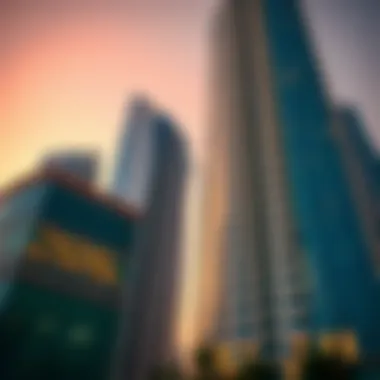
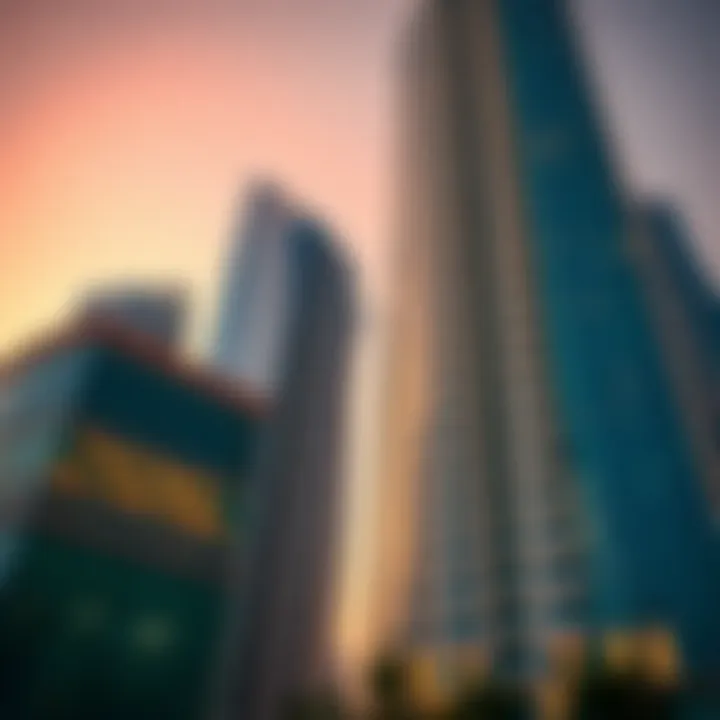
When one looks upon the architectural splendor around Burj Khalifa, it becomes clear that this area is much more than just the tallest building in the world. It's a hub of activity, featuring a plethora of prominent structures that effectively mold Dubai's urban environment. These buildings serve as functional spaces for business, leisure, and residential purposes, contributing to an ecosystem that radiates culture and modernity. Understanding the significance of these landmarks helps investors and residents alike appreciate the nuances of urban living in such a vibrant metropolis.
Dubai Mall
In close proximity to Burj Khalifa is the Dubai Mall, a veritable titan in the world of shopping and entertainment. Spanning over 1.1 million square meters, it holds the title of the largest shopping mall globally. This architectural marvel is not just about retail; it's a fusion of art, entertainment, and leisure. Attractions like the Dubai Aquarium, an ice rink, and the mesmerizing Dubai Fountain make it a quintessential destination for tourists and locals.
What sets the Dubai Mall apart is its design. The mall intends to create a complete experience rather than merely a shopping trip; it integrates cultural displays and art installations that resonate with visitors. This means that when people come to shop, they are also engaging with art and local culture. Such synergy makes it a key feature in the architectural landscape of Dubai, framing the Burj Khalifa in an environment that is both lively and sophisticated.
"Dubai Mall epitomizes the convergence of shopping and culture, making it a cornerstone of the urban experience at Burj Khalifa."
Armani Hotel Dubai
Adjacent to the glistening heights of Burj Khalifa, the Armani Hotel stands as a monument to luxury. Designed by the renowned fashion designer Giorgio Armani himself, the hotel is located within the Burj Khalifa and embodies understated elegance. Each detail, from the furniture to the lighting, has been meticulously curated to create an atmosphere of simplicity and refinement.
The significance of the Armani Hotel lies not just in its luxurious accommodations, but also in how it complements the Burj Khalifa. By epitomizing high-end lifestyle choices, it attracts a clientele that is aligned with the aspirations of the city itself—affluent, stylish, and international. For investors, the presence of such a high-profile establishment enhances the appeal of living nearby, showcasing a lifestyle marked by luxury and exclusivity.
Address Downtown
One cannot talk about prominent buildings near Burj Khalifa without mentioning Address Downtown. This hotel and residential complex offers breathtaking views of the surrounding skyline and is designed to cater to the needs of those who appreciate urban living at its best. With its blend of modern facilities and contemporary design, Address Downtown effectively complements the sleek lines of Burj Khalifa.
This building significantly contributes to the neighborhood's charm, acting as both a lavish hotel and a residential space. It seamlessly integrates sophisticated amenities such as gourmet dining and spa services, drawing in both short-term visitors and long-term residents. For potential homeowners, the Address offers not just a residence but a lifestyle that embodies the vibrancy of living in Dubai.
Shard Tower Dubai
Last but certainly not least is the Shard Tower. Though its name might seem to be a nod to the famed Shard in London, this Dubai iteration stands out as an architectural feat in its own right. It is designed to embody futuristic concepts, featuring glass facades and an array of sustainable technologies.
The Shard Tower adds to the architectural diversity of the Burj Khalifa area. Its innovative design speaks volumes about Dubai's commitment to architectural experimentation, offering a striking contrast to the more traditional designs found elsewhere. Investors looking for emerging opportunities can find great potential here, as the Shard represents a shift toward more sustainable, modern living environments.
Each of these buildings creates an anchor point in the rich architectural tapestry surrounding Burj Khalifa. They offer essential insights into not only Dubai's real estate market but also its cultural identity. Understanding the unique qualities of these structures allows potential homeowners and investors to foresee what the future might hold for them in this iconic part of the world.
Residential Developments Around Burj Khalifa
When one thinks of the iconic Burj Khalifa, it's easy to get lost in the towering presence of this architectural marvel itself. However, the residential developments around Burj Khalifa play a crucial role in shaping the neighborhood. These luxurious residences offer proximity to the heart of Dubai’s bustling metropolis while embodying the city’s modern vision.
Living near the Burj Khalifa means having a front-row seat to one of the most breathtaking skylines in the world. Potential homeowners are not just investing in property but also in a lifestyle that fuses comfort, elegance, and modern conveniences. Let’s delve into the residential jewels defining this vibrant real estate landscape.
The Residences at Burj Khalifa
The Residences at Burj Khalifa represent the pinnacle of luxurious living. Located on levels 19 to 108 of the skyscraper, these exclusive apartments boast panoramic views of the city below, appealing especially to wealthy expatriates and investors. The benefits of residing here are self-evident:
- Unmatched Views: Imagine sipping coffee while gazing at the dazzling cityscape and the sparkling waters of the Dubai Fountain.
- Access to Amenities: Residents enjoy top-of-the-line amenities, such as a state-of-the-art fitness center, pool, and spa, making it an all-inclusive living experience.
- Prestigious Address: Owning an apartment here offers more than just a home; it embodies a prestigious address that can elevate one's status.
Living in these residences feels like being part of a select club, with social events and networking opportunities that come with the territory. This has made The Residences at Burj Khalifa a hot spot for individuals who relish the finer things in life.
Burj Vista
Burj Vista stands as a prominent feature adjacent to the Burj Khalifa, offering a blend of architectural elegance and modern living. The development comprises two towers that provide a premium living experience and a sense of community. Here’s what makes Burj Vista noteworthy:
- Community Feel: Unlike high-rise living that can sometimes feel isolating, Burj Vista's layout encourages interaction among residents, creating a neighborhood vibe.
- Convenient Location: Situated close to the Dubai Mall and other attractions, residents have everything at their fingertips—dining, shopping, and entertainment all within walking distance.
- Modern Facilities: Burj Vista is equipped with facilities like swimming pools, gyms, and recreational areas, designed to enhance the quality of life.
With both residential and leisure aspects combined, Burj Vista offers a unique living arrangement that caters to both families and young professionals alike.
South Ridge
South Ridge provides a more tranquil alternative yet remains within striking distance of Burj Khalifa. This development captures the spirit of Dubai's urban landscape while promoting a peaceful lifestyle. Here are some key points about South Ridge:
- Family-Friendly Environment: South Ridge is characterized by its grassy parks and communal spaces, ideal for families seeking comfort and safety.
- Design and Architecture: Its design reflects a blend of modern and traditional elements, showcasing a style that resonates with many residents who appreciate cultural nuances.
- Accessibility: Being positioned just a short stroll from the Dubai Mall grants residents the luxury of spontaneous outings without the need for lengthy transportation.
Ultimately, South Ridge's focus on creating a serene refuge amid the bustling city makes it a favored choice for those looking to strike a balance between vibrancy and tranquility.
"The architectural canvas surrounding Burj Khalifa isn’t just about towering buildings; it’s about a lifestyle interwoven with the very essence of Dubai."
Commercial Spaces and Offices
The area surrounding Burj Khalifa is not just a haven for residential allure; it also houses key commercial spaces that play an instrumental role in shaping Dubai’s vibrant economy. As the heart of Dubai's business hub, these offices and commercial edifices cater to a diverse range of industries, from finance to technology. Understanding these spaces is vital for investors and entrepreneurs looking to tap into the expansive growth potential offered by Dubai’s rapidly evolving landscape.
Dubai International Financial Centre
The Dubai International Financial Centre, often referred to as DIFC, stands as a key symbol of Dubai's commercial ambitions. Established as a financial free zone, DIFC provides a regulatory framework that supports international financial services. With its striking architecture that blends modern aesthetics with functionality, this district is home to numerous global corporations, law firms, and financial institutions.
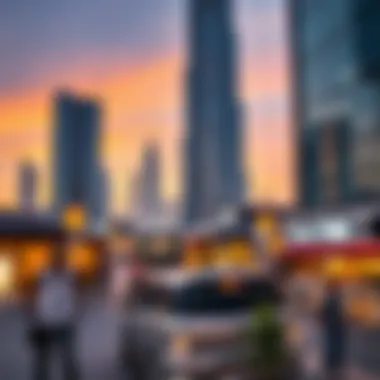
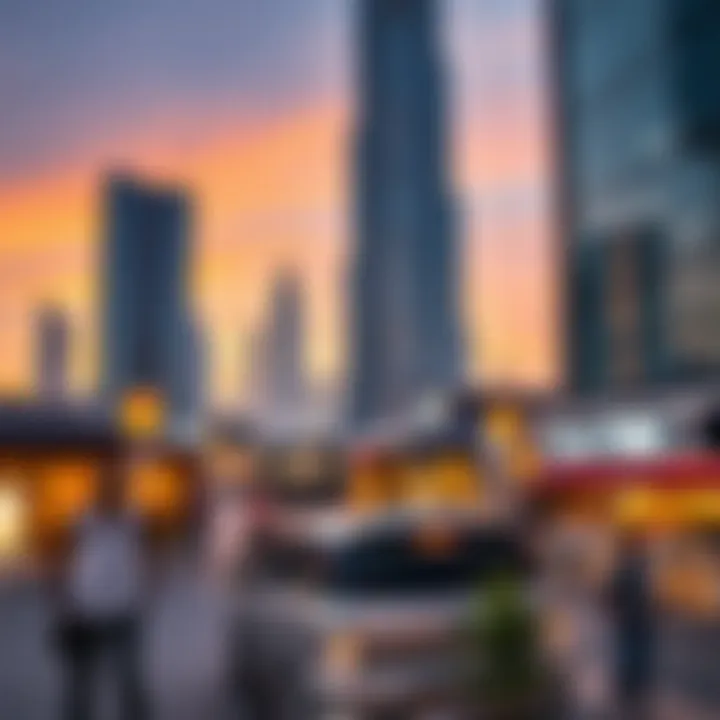
Visitors to DIFC can expect a lively scene teeming with professionals and innovators. The area is more than just skyscrapers; it features art galleries, fine dining restaurants, and retail spaces, making it a dynamic environment for business and leisure. The presence of heavyweights like the Dubai Financial Services Authority (DFSA) and the London Stock Exchange Group lends credibility, fostering a rich ecosystem for networking and collaboration.
- Key Features:
- Offers a favorable tax regime for businesses.
- Serves as a strategic hub connecting markets across Europe, Asia, and Africa.
- Houses the region's largest financial institutions, ensuring a steady flow of business.
The hustle and bustle of Dubai International Financial Centre makes it an appealing location for expatriates seeking new career opportunities, especially in finance and consultancy.
Business Bay Towers
Just adjacent to Burj Khalifa, Business Bay Towers encapsulates the entrepreneurial spirit of Dubai. Launched as part of a larger urban development project, this area is an energetic blend of commercial and residential spaces. Designed with modern architecture in mind, Business Bay features high-rise towers that offer breathtaking views of the surrounding skyline.
These towers host a wide range of businesses—from small startups to multinational corporations—thereby creating a collaborative community. The flexibility of office spaces allows businesses to scale quickly, essential for any investor looking to leverage Dubai’s booming market. The proximity to key amenities, such as hotels, dining options, and leisure facilities, makes Business Bay a practical choice for companies aiming for visibility and accessibility.
- Highlights:
- Integrates both commercial units and residential options, promoting a work-life balance.
- Central to the city's transport networks, ensuring ease of movement for employees and clients.
- Enriched by lush green spaces and waterfront features, which enhance the work environment.
In summary, the commercial landscape around Burj Khalifa is not only about impressive architecture but also about creating a functional ecosystem that supports business growth. Whether it’s at the thriving Dubai International Financial Centre or within the dynamic spaces of Business Bay Towers, opportunities abound for those willing to harness the potential of this bustling metropolis.
“Investing in the right commercial space can unlock remarkable possibilities within Dubai’s ambitious framework.”
For more insights about commercial opportunities in Dubai, consider exploring resources such as Dubai Economy and Free Zone Authority.
Impact on Dubai's Real Estate Market
The Burj Khalifa, a giant of steel and glass, is not just an architectural marvel; it's the linchpin of the real estate scene in Dubai. The presence of this towering icon influences the market in ways that extend far beyond its impressive height. Each building nearby has an intricate relationship with this structure, crafting a narrative of urban evolution that appeals to investors, homeowners, and expatriates alike.
Market Trends
Dubai's real estate market is as dynamic as the city itself, and the Burj Khalifa plays a vital role in shaping current trends. The area around it has become a beacon for luxury living and high-end commercial spaces. Investment here often translates into lucrative returns, driven primarily by the unyielding demand for prime property near the world's tallest building.
- Real Estate Price Surges: Since Burj Khalifa’s inception, property prices in the vicinity have experienced a noticeable increase. A report by Property Finder indicated a significant rise in property values, reflecting the appeal of living next to such a landmark.
- Luxury Segment Boom: The arrival of high-net-worth individuals has fortified the demand for luxury apartments and penthouses. Properties with a view of the Khalifa not only command higher prices but also offer a lifestyle infused with exclusivity and elegance.
- Mixed-Use Developments: The rise of mixed-use developments, combining residential, retail, and office spaces, has further transformed the landscape. These projects create vibrant ecosystems and attract a diverse crowd, enhancing foot traffic and increasing property value.
"The Burj Khalifa's role in the Dubai real estate scene is akin to a lighthouse guiding investments towards fertile ground."
The demand generated by tourists visiting the Burj Khalifa engenders a ripple effect, boosting local businesses and consequently spurring real estate developments nearby, creating a safe bet for savvy investors.
Investment Opportunities
With an eye on the future, investing in Dubai's real estate near the Burj Khalifa presents several promising avenues. This space isn't just about immediate gains; it's a core piece of a long-term strategy for capital growth.
- Residential Investments: Properties such as The Residences at Burj Khalifa or Burj Vista have proven to be goldmines for investors. The attractive rental yields, often above 7%, make these options alluring for long-term buy-and-hold strategies.
- Commercial Leases: With the increasing number of corporations setting up shop in this thriving locale, commercial properties can yield substantial rental income. The area's all-encompassing infrastructure caters to multinational companies aiming for visibility and prestige.
- Emerging Developments: Opportunities abound in upcoming projects slated for the area. With plans for further amenities and enhancements to public spaces, properties here are likely to appreciate even further, making them a smart choice for early investment.
Tourism and Visitor Attractions
Tourism significantly shapes the architectural narrative of the area surrounding Burj Khalifa. This icon does not just attract visitors for its towering height; it serves as a gateway that opens up a hushed curiosity about the structures that partner it in crafting Dubai's skyline. Visitors and investors find themselves drawn to the vicinity not only for its aesthetics but also for the myriad attractions that lie within arm's reach, making it a vibrant hub buzzing with activity.
Attraction Dynamics
A multitude of attractions surrounds Burj Khalifa, each offering a unique experience. The Dubai Mall sits like a behemoth adjacent to the tower, drawing in tourists with its blend of high-end shopping and entertainment options. Inside, visitors can find the Dubai Aquarium, which acts like a portal into underwater wonders. This mall features over 1,200 retail shops, making it a must-visit extravaganza for shopaholics.
The Dubai Fountain further enhances the attraction dynamics. It is more than just a water feature; it performs a choreographed dance to music, captivating onlookers with its mesmerizing displays. Coupled with vistas of Burj Khalifa, the fountain creates a visually stunning scene that beckons tourists to linger.
Another essential aspect is the various cultural and heritage sites within short distances. The historic Dubai Creek and Al Fahidi Historical Neighborhood provide stark contrasts to the modern facades of the high-rises, framing a broader context of the city’s rapid development.
Here’s a list of popular attractions nearby:
- Dubai Mall: A shopping paradise and entertainment hub.
- Dubai Fountain: The world’s largest dancing fountain, located at the base of Burj Khalifa.
- At the Top, Burj Khalifa: Observation decks offering sweeping views of Dubai.
- Souk Al Bahar: An Arabian marketplace with boutiques and restaurants.
These attractions meld seamlessly into the experience that visitors seek, making the area a rich tapestry of leisure and culture.
Visitor Experiences
The experience of visitors near Burj Khalifa is multifaceted, combining leisure, discovery, and cultural engagement. For tourists, the journey often begins a few levels below the tower itself. The trip to the observation deck at the top is a rite of passage, allowing many to forget about their daily worries as they ascend nearly 828 meters above the ground. The elevator ride offers a prelude of excitement, as visitors marvel at the futuristic design and the speed at which they rise.
However, the experience doesn’t end there. Once at the top, guests are greeted with panoramic views that stretch as far as the eye can see, sealing the tower's reputation as a marvel.
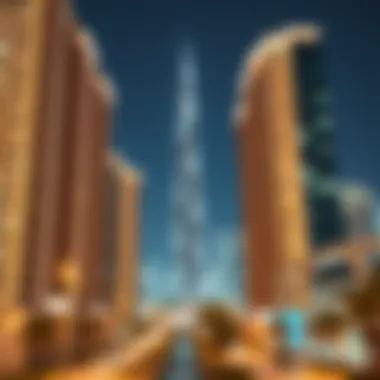
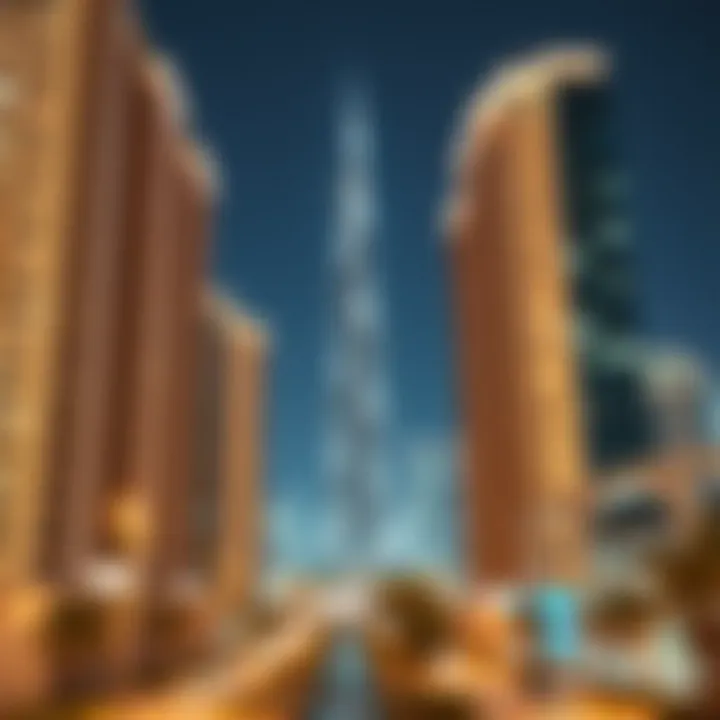
Additionally, guided tours offer enriched narratives that lend insight into the tower's design philosophies and engineering feats. Visitors can choose from a mix of local food experiences, thrilling rides, and historical explorations, creating a palette of memories not soon forgotten. And when the sun sets, the area transforms into a lively place, with cafes and restaurants buzzing with chatter, enhancing the communal vibe.
"To visit the area around Burj Khalifa is to step into a realm where every view could be a postcard, every moment a memory."
All these experiences reflect how the architectural landscape and tourism symbiotically enhance how Dubai is perceived. With each building telling its own story, they form a unified narrative that defines the city while entrenching the Burj Khalifa firmly in its central role.
Architectural Styles and Influences
The architectural styles and influences surrounding the Burj Khalifa reflect not only the ambitions of Dubai but also the cultural exchanges that shape its skyline. This section aims to familiarize investors, homeowners, and aficionados with the styles that define this vibrant area. From sleek modernism to culturally infused designs, these architectural narratives illustrate how buildings can be more than mere structures—they become symbols of identity and innovation.
Modernism in Dubai
Modernism in Dubai represents a significant shift in urban design paradigms. Mostly characterized by minimalistic aesthetics, clean lines, and functional forms, this style has become a hallmark of Dubai's transformation into a global metropolis. The use of glass and steel is prevalent, allowing buildings to reflect light and showcase the stunning desert landscape. For instance, the Burj Khalifa itself embodies this modernist ethos with its tapered spire reaching high into the sky, designed to emulate the stem of a desert flower.
- Key Features of Modernism:
- Simplicity: A focus on reducing unnecessary ornamentation to enhance functionality.
- Connection to Nature: Structures integrate harmoniously with outdoor spaces, often including elements like terraces or gardens.
- Technological Innovation: Use of cutting-edge materials and construction techniques pushes the boundaries of what is architecturally possible.
In a way, modernism in Dubai isn't just about buildings; it embodies a lifestyle—one that aspires to blend luxury with efficiency. The clean, slick profiles of structures like the Dubai Mall emphasize this principle. Investors seeking profitable ventures in areas marked by modernist designs can expect a rise in value, as these spaces continue to attract discerning clientele looking for contemporary convenience blended with luxury.
Cultural References in Architecture
Cultural references in architecture serve as a reminder of the unique heritage of Dubai, even amidst its modern advancements. Many buildings in the vicinity of Burj Khalifa are inspired by regional art, crafts, and historical references, which help to create a sense of place. The adaptation of traditional Islamic design elements into modern architecture invites visitors to experience a juxtaposition of the past with the present.
- Examples of Cultural Influences:
- Mashrabiya: This architectural feature allows for privacy while enabling airflow and natural light, subtly reflecting the cultural values of modesty and communal living.
- Calligraphy and Geometric Patterns: Seen in various buildings, these artistic elements often bring historical significance to the modern context, acting as a bridge between eras.
- Courtyards and Water Features: These not only provide a cooling effect but also echo the traditional Arabian homes, making modern developments more welcoming.
"Architecture can often be a silent voice of cultural identity, silently narrating the stories of its surroundings."
Integrating cultural references adds depth, making commercial and residential properties captivating for both locals and expatriates. Understanding these influences can lead investors to appreciate properties’ value beyond mere aesthetics, considering the emotional resonance they may carry for future inhabitants.
In summary, the architectural landscape surrounding Burj Khalifa depicts a sophisticated melding of modernist principles and cultural references. This dual narrative is essential for understanding the allure of the area for both investors and residents—where high-rise sophistication meets cultural richness. As the horizon of Dubai continues to evolve, so too will the stories these buildings tell.
Future Developments and Plans
The landscape surrounding Burj Khalifa is not stagnant; it continues to evolve at a pace that reflects the ambitions of Dubai as a thriving metropolis. Understanding the future developments and plans in this area offers insights into the strategic direction of urban design and real estate within this international hub. Investors, homeowners, and expatriates alike will find immense value in recognizing how these developments can influence property values and the overall appeal of living or working so close to one of the world’s tallest skyscrapers.
Upcoming Projects
A slew of upcoming projects aims to further enhance the urban fabric of Dubai. These developments promise to blend functionality with aesthetic brilliance, constructing a harmonious relationship with the existing structures. Some notable projects include:
- Dubai Creek Tower: Set to surpass the Burj Khalifa in height, this architectural marvel will be a centerpiece for a new urban district, prioritizing a seamless blend of nature and architecture.
- The Dubai Lighthouse: Positioned within the Dubai Marina area, this project is intended to provide both commercial and residential spaces, with a design that offers a nod to the maritime heritage of the region.
- The Hospitality District: Designed to cater to the increasing tourism wave, new hotels and leisure facilities are being planned to accommodate visitors to the Burj Khalifa, thereby enriching the overall experience for tourists.
Each of these developments is a cog in the larger wheel of urban growth. They are not just structures but are intended to create communities, accommodating the lifestyle and demands of the modern resident or visitor.
Long-Term Vision for the Area
Looking ahead, the long-term vision for the area surrounding Burj Khalifa encapsulates a broader understanding of urban development. The plan outlines priorities for sustainable growth, emphasizing eco-friendly infrastructure and smart city initiatives. This is particularly crucial in a place known for its extravagance; it seeks to strike a balance between innovation and environmental responsibility.
- Sustainable Practices: Future planning will integrate green spaces with urban developments, promoting biodiversity within the city confines. Plans for solar energy use and water conservation systems strive to position Dubai as a leader in sustainable urban architecture.
- Smart City Features: Technological advancements will see the implementation of smart traffic systems, waste management solutions, and energy-efficient designs in newly erected buildings. This proactive approach is expected to enhance the quality of life for residents and efficiency in service delivery.
"The future of the area surrounding Burj Khalifa is not merely about taller buildings, but a thoughtful evolution towards smarter, greener living spaces."
In short, the future is bright for this iconic area, with developments focused on creating an inclusive environment that meets the needs of its diverse population. Potential investors and homeowners should keep a keen eye on these developments, as they promise to shape the landscape and possibly their investment decisions for years to come.
Epilogue
The exploration of the architectural landscape surrounding the Burj Khalifa reveals a complex interplay between design, function, and cultural relevance. The structures that crowd around the Burj Khalifa do not merely exist as separate entities; they create an intricate tapestry that defines Dubai’s urban fabric. Each building stands as a reflection of contemporary values, aspirations, and innovation within the broader context of a rapidly evolving city.
Reflections on Architectural Integration
Examining how various architectural styles converge illustrates a seamless integration of space. The nearby buildings transcend their individual roles, contributing to a cohesive visual narrative that portrays Dubai's ambition. For instance, the juxtaposition of sleek modernism found in the Dubai Mall and the luxurious textures of the Armani Hotel Dubai articulates a dialogue that speaks to both luxury and accessibility. The transitions between commercial spaces, residential blocks, and cultural venues highlight that architecture here is not just for show; it's a functional part of everyday life, inviting pedestrians, homeowners, and business professionals to engage with the space. This integration generates a vibrant atmosphere that sparks creativity and fosters community interactions, making it a welcoming hub for visitors and a comfortable haven for residents.
The Economic and Cultural Relevance of the Area
The economic impact of the surrounding infrastructure cannot be understated. Properties in the vicinity of Burj Khalifa have shown resilience and growth, appealing to investors looking for lucrative opportunities. With a surge in tourism and a thriving business district, areas such as Business Bay Towers and the Dubai International Financial Centre have become hallmark investment zones.
Culturally, this locality offers significant value. It has become a melting pot of global influences, showcasing various architectural themes that mirror the city’s multiculturalism. From luxury brands to local artisans, the businesses around the Burj Khalifa cultivate a rich shopping experience that informs both economic stability and cultural exchange.
In summary, the neighborhood surrounding Burj Khalifa is more than real estate; it's a living entity that encapsulates the essence of modern Dubai. Investors, homeowners, and expatriates need to appreciate not just the aesthetics but the underlying economic and cultural significance that enhances the appeal of living and investing in this iconic area.
"The synergy of commercial vitality and architectural brilliance creates a dynamic landscape that continues to define the future of Dubai."
For further insights on Dubai’s ongoing architectural evolution, consider checking resources such as Wikipedia for a historical perspective, or Britannica for broader context.



